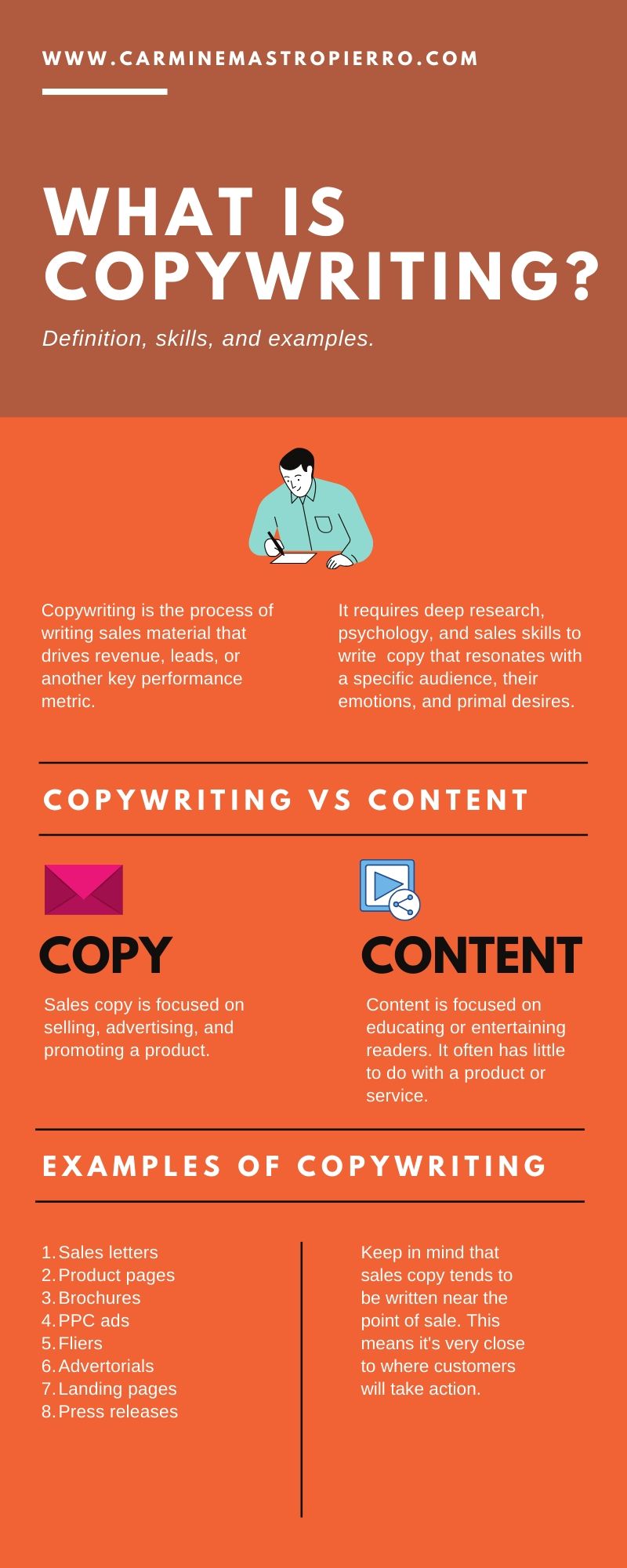What is copywriting?
What skills do you need to be a copywriter?
Understanding exactly what copywriting is and the skills needed to be a great copywriter are crucial if you want the best results for your project.
Whether you’re looking to hire a copywriter or write material yourself, you need to understand the basics.
I’m talking copywriting definition, skills, and seeing real-life examples.
And that’s precisely what I’m covering today.
Let’s jump right into it.
What is copywriting?
According to Google, the definition of copywriting is:
The activity or occupation of writing the text of advertisements or publicity material.
I like to define it as the process of writing business material that generates results, whether that’s website traffic, leads, sales, or another KPI.
Remember that copywriting isn’t journalism or crafting editorials.
Your goal when writing copy isn’t to entertain or tell readers about the news but rather to sell.
It should entice the reader to take action that furthers them along the sales funnel.
This is also why copywriters need to be very well-rounded in terms of marketing skills.
For example, I have 8+ years of experience doing SEO, lead gen, conversion rate optimization, and other practices.
I apply all of these skills to the content and copy I produce, which ultimately helps it do something.
If your copy isn’t doing something, then you’re doing it wrong.
Watch my video on if copywriting is right for you to learn more:
Copywriting vs content writing
Writing content for blogs gets commonly mixed up with copywriting.
Heck, I use these two words interchangeably sometimes, too.
Let’s get picky, though.
Copywriting can be defined as sales material that promotes a product. These include:
- Landing pages
- Sales pages
- Sales letters
- Product pages
- Web pages, in some cases
- Brochures
- Flyers
Here’s a Facebook ad from GoDaddy for illustration:
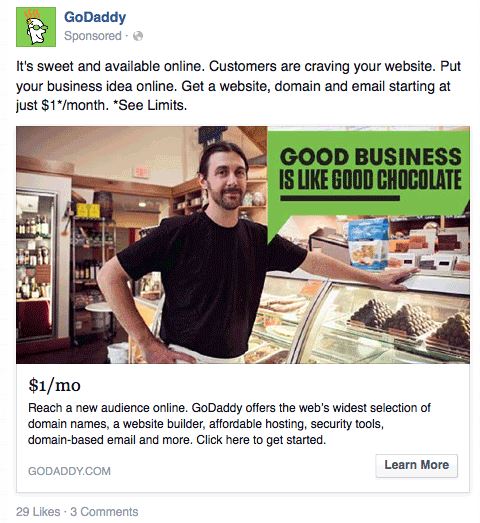
Content writing, on the other hand, is producing articles for blogs and publications such as this QuickSprout article:
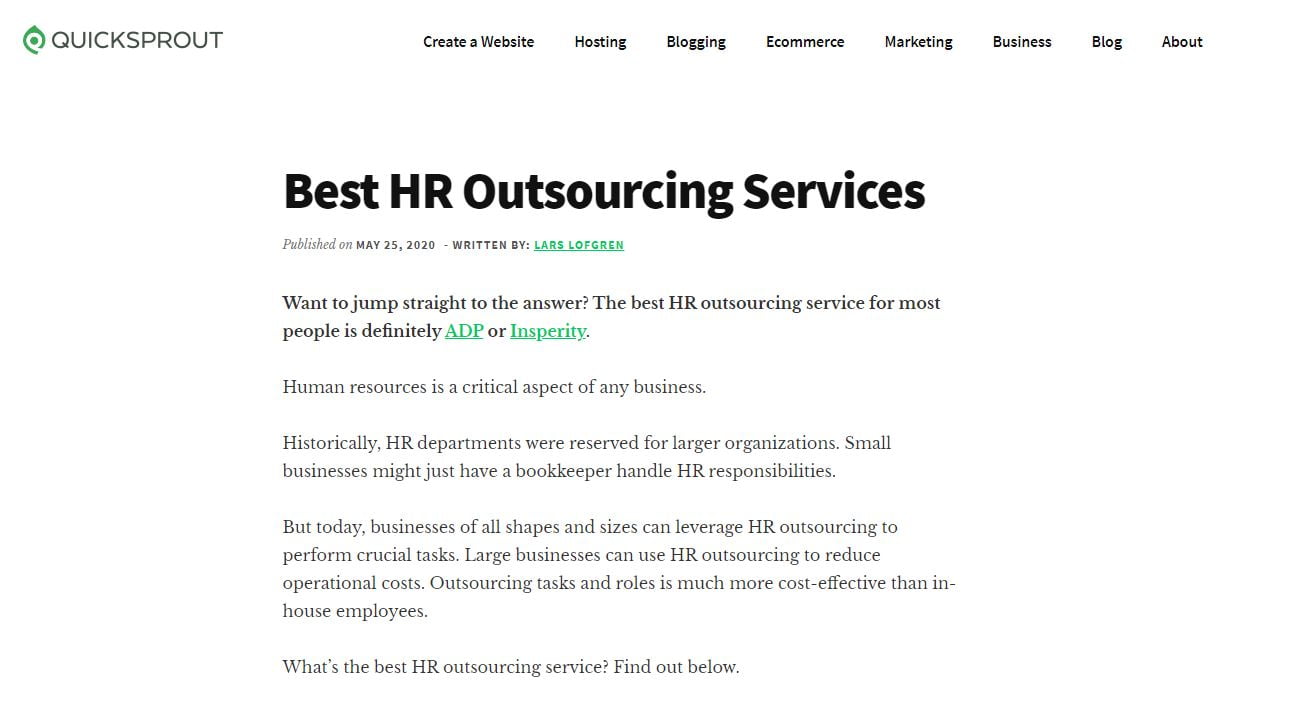
They both require different sets of skills and expertise, with some being similar.
This brings me to my next point.
Copywriting skills (And what does a copywriter do?)
What skills do you need to be a copywriter? Quite a few, actually.
A good copywriter is well-rounded and sharp.
They can perform deep research quickly, put themselves in the customer’s shoes, and more.
Let me elaborate.
Being able to research any industry or topic
There have been countless projects clients presented me in which I had very little working knowledge.
They included specific industries and deep topics within them.
But that’s one of many hats you wear as a copywriter…
To become an expert on any subject.
When I begin a new project with a client, one of the first steps I take is to gather:
- Blog posts
- Internal documents
- Market reports
- Reviews and testimonials
- Whitepapers
- Case studies
- Etc
I collect this material and study it to learn about the industry, its customers, and trends, and extract as much data as possible.
Every writer needs to do the same.
Additionally, primary research, such as leveraging questionnaires and interviews, allows you to get proprietary data for every copywriting project.
Ask questions about the product like:
- What are its features and benefits?
- What’s the unique value proposition?
- What pain point does it solve?
- How much does it cost, and how can it be justified?
- Is there a guarantee?
Then, ask questions about the audience, such as:
- What are their demographics and psychographics?
- What beliefs, feelings, and desires do they have around the product?
- What problems do they need to be solved?
- What questions or objections would they have?
- What motivates the buyer?
Sales copy also needs an abundance of data, statistics, and quotes to make it credible.
This proves any claims you make and builds trust with the reader.
Emotional intelligence
I think emotional intelligence and empathy are some of the most underrated business skills.
They aren’t measurable and can’t necessarily be taught, but damn, are they important.
Being able to empathize with customers allows you to understand why they’re seeking a product, the emotions they’re feeling, and similar circumstances.
Seeing as the purchasing process is heavily emotional, sales copy needs to include emotional statements, questions, and stories.
Having a lot of empathy for others will translate well into writing copy.
Gary Vaynerchuk talks about why it’s so important in this quick two-minute video:
Put yourself in the reader’s shoes when you’re writing. It’s something that you’ll gradually become better at.
What would they be thinking? Feeling? Translate that into the sales copy, so they resonate with it much deeper.
You can also imagine speaking with your ideal customer face-to-face over coffee. ☕
What language would you use? What do they ask about?
These exercises ultimately help you write much empathetic business material that drives growth.
Editing and proofreading
It’d be nice to finish one round of copy and be done, right?
Unfortunately, it doesn’t work that way.
Edits, revisions, and proofreading are mandatory parts of the copywriting process.
This is exactly why you need to spend time editing every piece of copy you write once the first draft is done.
Try using a tool like Jasper to help you write and edit copy faster with the power of AI.
I once learned from a book called The Copywriter’s Handbook by Robert Bly that you should write copy as fast as possible.
This is to ensure that you use the emotional and creative side of your brain.
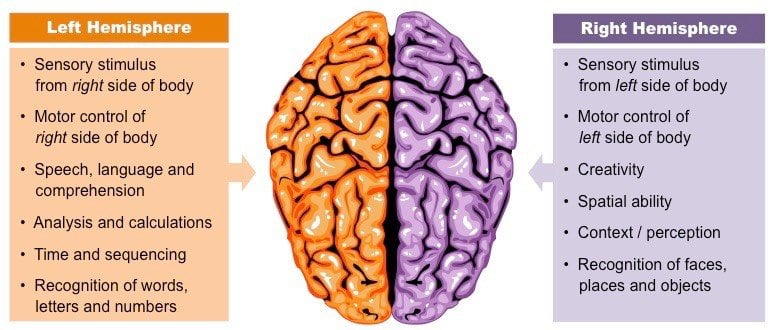
The longer you stop to think about what you’re writing, the more logical it becomes.
Your material shouldn’t look like a caveman wrote it, but it needs to be emotionally driven.
I also love this practice because you get a lot of work done fast, which feels great and motivates you to keep going on the project.
This brings you to the editing stage, where you are going to clean up any mistakes you made in terms of accuracy, grammar, etc.
Start learning to be a non-perfectionist when you write and edit later.
But, what exactly should you look for when editing and proofreading?
I recommend starting small with punctuation, grammar, and spelling. These are easy to spot, especially with tools like Grammarly or Hemingway Editor.
Then, improve the structure and formatting of the sales copy.
Break up sentences and paragraphs. Reorganize ideas so they make more sense.
Check for a logical flow of points. Every idea should naturally transition into the next and align with what customers are thinking.
Read my copyediting checklist to learn more.
Organization is key
Being organized is crucial as an entrepreneur of any sort, including a copywriter.
As a writer, you’re going to collect heaps of resources, as I mentioned earlier.
You will be playing with a lot of information, templates, and guidelines, so it’s critical you remain organized.
If you feel messy physically, you’re going to feel messy mentally. I’ve always sworn to keep a neat office and clean up my online tools.
You should have folders for everything like client projects, content guidelines, and swipe files.
No writer should ever have to scramble to find references or spend unneeded amounts of time doing filing like a secretary.
I highly recommend everybody, regardless if you’re a writer or not, to read the book Getting Things Done by David Allen.
My entire time management and productivity game are based on his teachings and strategies.
They work. And really damn good at that.
Watch my video on freelance writing productivity to get more ideas.
You need to understand SEO
If you’re writing blog posts, web pages, or similar online content, you NEED to understand SEO.
Gah.
It makes me cringe when copywriters don’t understand the fundamentals of on-page SEO and try to offer content writing services.
You don’t need to be an SEO wizard or spend $1,000 on a course to learn the basics, either.
I’d recommend learning about keyword research and on-page ranking signals.
Create a blueprint and rules you can follow for every piece of content you write for clients.
When they see their rankings and traffic shoot up because of you, they will want to work with you for life!
Here are articles I wrote to learn more about SEO:
- The Definite Guide to SEO Writing
- On Page SEO Checklist That Will Skyrocket Your Rankings to The First Page
- 7 SEO Tools That Will Increase Organic Traffic, Backlinks, and Rankings
One of the first things you need to get good at is keyword research.
You must be able to find search terms that have good traffic but low competition.
I suggest using a tool like Wordtracker or SEMrush. Enter a topic on the home page and click the search button.
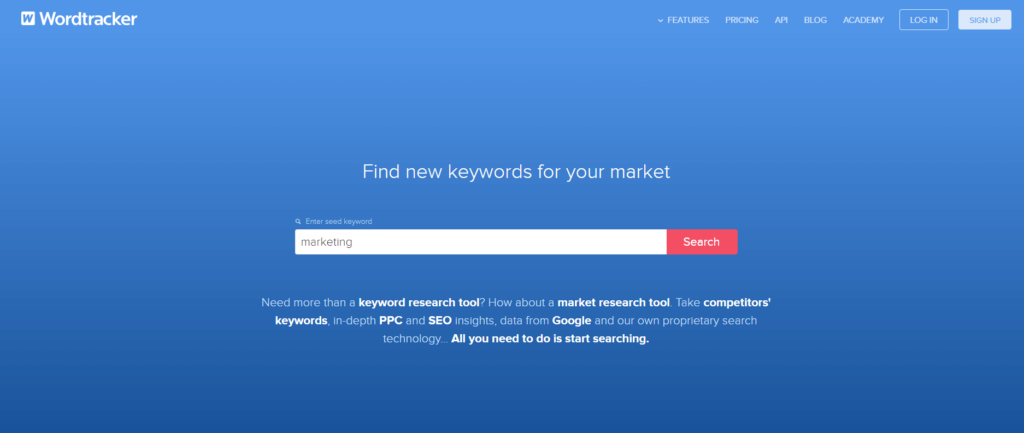
This will give you keyword data and suggestions.
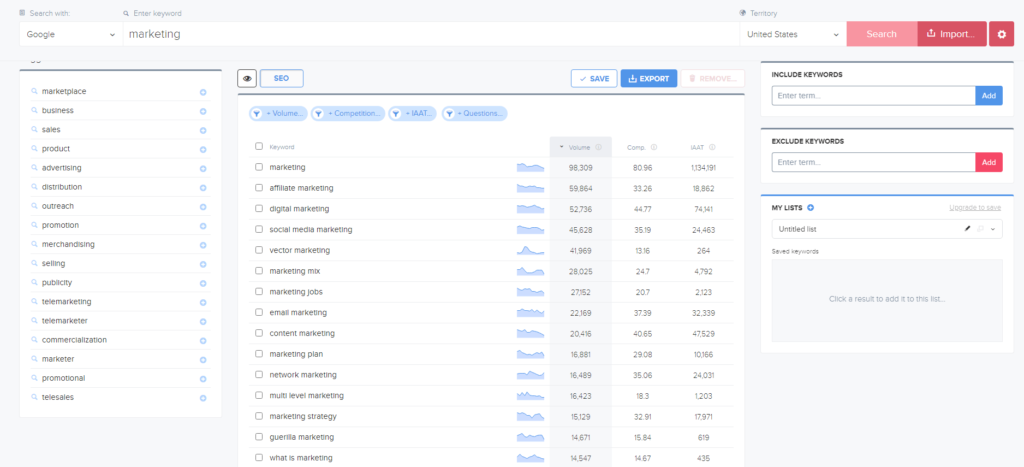
Ideally, you will want to target phrases that have as little competition as possible with as much volume.
Export keywords you plan to use or save them by upgrading to Wordtracker’s trial/paid plan.
Secondly, use target keywords in all of the areas that search engine algorithms scan. These include:
- The title tag
- The meta description
- The URL
- The body of the page
- Header tags
- Media file names
- Alt text of media
You can also use SEMrush to audit websites, analyze competitors, and more to improve your SEO copywriting.
Ooze charisma
I firmly believe in forming an organic relationship with all of the clients I work with.
But it’s a two-way street.
I have to be a good energy, too.
I’ll never work with a stubborn or negative client in my life.
Been there, done that. No thanks!
Not only does it make the project more difficult and less fun, but it doesn’t align with my values or who I am.
I like to think I’m a naturally positive and charismatic person, and it really shines when offering services.
Some of my main goals are to make the client’s life as easy as possible, be easy to work with, flexible, and be fun.
But what the heck is charisma anyway? Can you learn it?
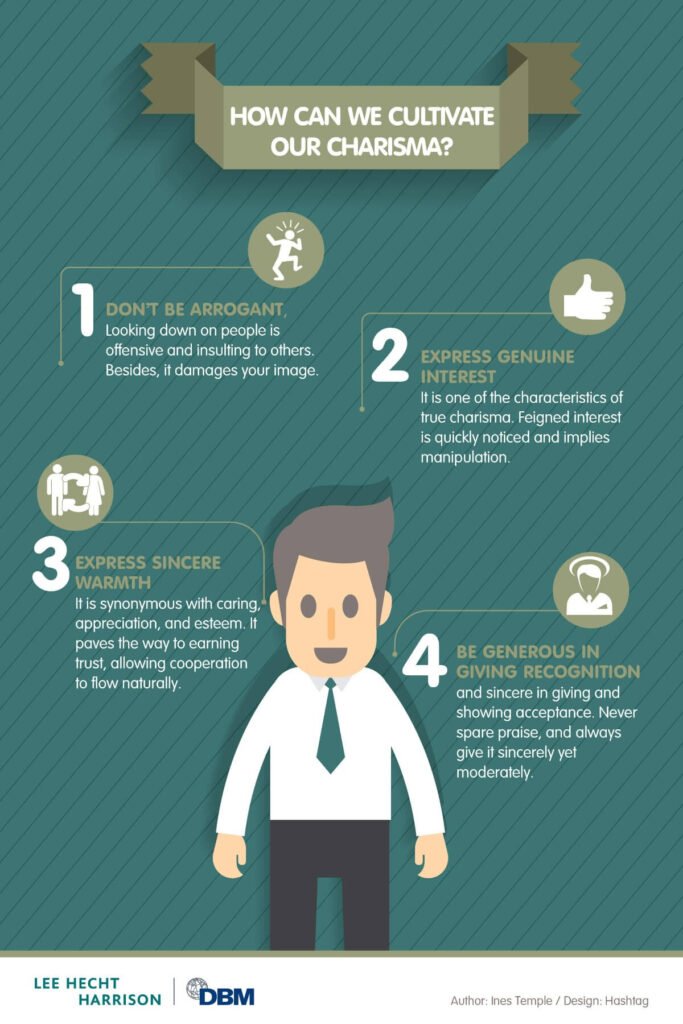
The first thing you can do to cultivate charisma is to be warmer and more accepting. Don’t insult clients or get upset with them.
Express genuine interest in helping them, taking on their project, and solving their problems.
Be grateful for the opportunity if you begin working together.
Find ways to overdeliver and go above and beyond what you promise.
Doing these things will leave lasting impressions on clients, create long-term engagements, and get you profitable referrals.
Sales, sales, sales!
If you’re going to pitch clients and make the big bucks as a copywriter, you better know your sales skills.
I’m talking about pitching, negotiation, following up, handling objections, etc.
This also translates into the copy you produce because you will understand how to sell and grab attention with words.
So, what are some of the main sales skills you need?
The first is overcoming objections.
People naturally object to products and services. They are skeptical.
If you’ve done your research, you know what questions customers may have and can answer those within the material.
This will create less friction when they are purchasing and makes them more comfortable doing so.
If you need mentorship with closing clients and growing your writing business, check out my copywriting bootcamp.
Secondly, rapport building is extremely important.
I like using storytelling to build an emotional connection with the reader.
Make it relate to their experience and how you were once in a similar situation. Or, highlight previous customers.
Address their wants, needs, and desires. This shows that you have empathy and really understand who they are.
Thirdly, work on clearly communicating the benefits of what you’re selling.
It’s easy to get stuck on features and small details that don’t excite people.
Help them use their imagination!
What emotions would they feel? What pain point would be relieved?
What makes it better than anything else on the market?
Developing these types of sales skills will 10x your writing. 💪
Why is copywriting important?
Words are powerful. Very powerful, in fact.
Every single word and phrase makes us feel and think something different.
The purchasing process is heavily emotional, primal, and driven by desires we often don’t even know we have.
That’s why copywriting is important. It’s way too easy to think you can slap on any words onto an ad and think the money will start rolling.
Not even close.
Copywriting is a science that uses the psychology of language and marketing to sell products.
Without it, your ads and content will blend into every other website like a water drop into an ocean.
Hiring an experienced copywriter might be one of the best investments you make for your business.
Think about it.
If you pay a copywriter $10,000 for a sales letter and it generates hundreds of thousands of dollars, it’s fair to say that’s a good ROI, right?
They understand the psychology of persuasion, selling, and are capable of translating it into words.
The end result is an advertisement, promotion, or piece of content that yields incredible performance while stomping mediocrity.
According to research, 79% of people scan new pages they come across and 16% read word by word.
It’s your job as a copywriter to capture both crowds. Create sales copy so good that it grabs the attention of those skimming through or reading carefully.
Nielsen Norman Group also discovered that concise text, scannable layouts, and objective language result in the greatest usability of web pages.
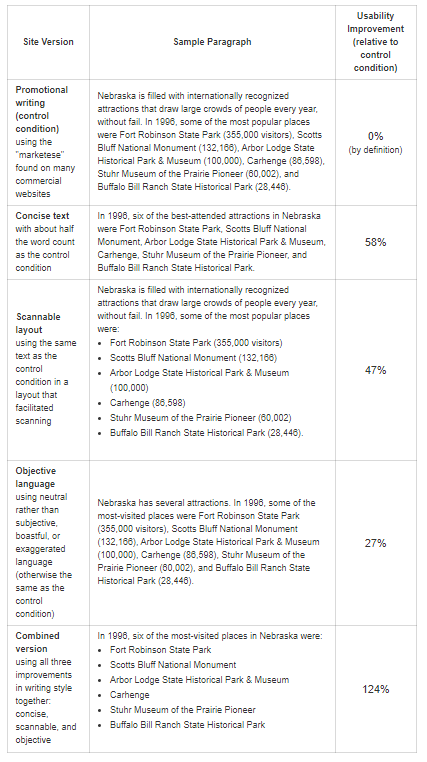
At the end of the day, every facet of business (emails, landing pages, etc.) is made up of sales copy. It has a huge impact on how people experience reading and interpreting your business.
Copywriting examples
If you’ve asked, “What are examples of copywriting?” you’re in the right place.
With the foundations of copywriting out of the way, let’s look at some real-world examples of great sales copy in action.
David Ogilvy and Hathaway
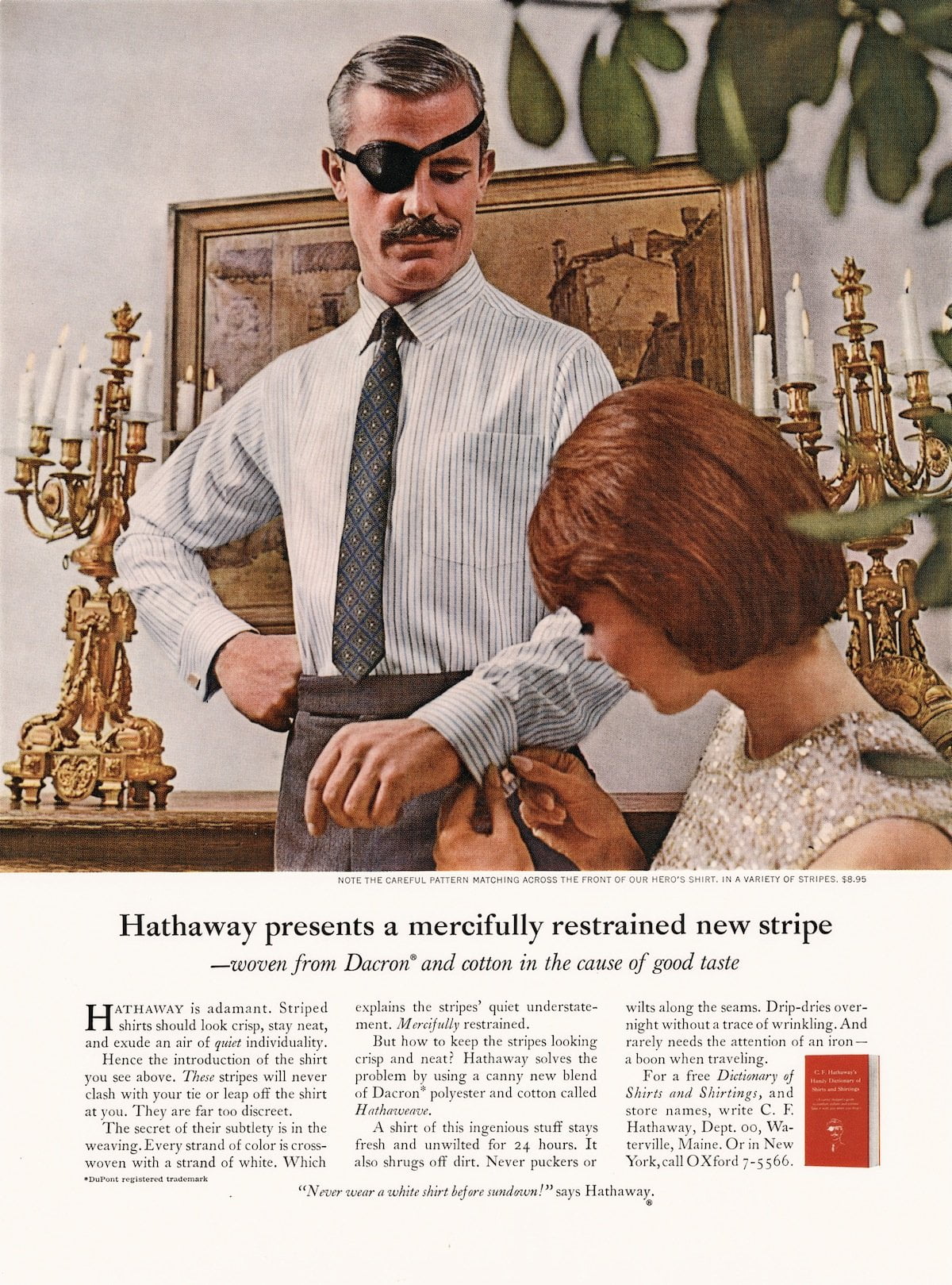
One of the most legendary advertisement’s ever written is the one David Ogilvy produced for Hathaway’s dress shirts.
It featured the iconic man with an eye badge that caught everybody’s attention off guard. It was both creative and sales-forward.
More importantly, the copy is perfect.
Notice how David speaks about how a Hathaway shirt won’t clash with a tie, be too overwhelming, and looks crisp at all times.
He also mentions Hathaway’s new blend of material that you can’t get anywhere else, which stays fresh for up to 24 hours.
David Ogilvy and Rolls Royce
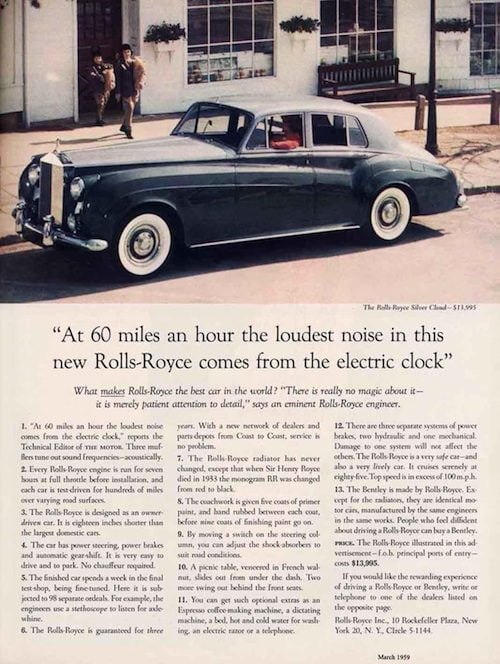
Ogilvy is my favourite copywriter of all time, so I’m a little biased for including him multiple times. However, let the copy do the talking.
This is another iconic ad he wrote for Rolls Royce with the famous headline, “At 60 miles an hour the loudest noise in this new Rolls-Royce comes from the electric clock.”
That line summed up the luxury and comfort a Rolls Royce car delivers. It also stood out from the other vehicles being sold in 1959, which were notoriously noisy.
It serves as a great example of how a headline will get customers reading the rest of the copy and further toward the sale.
Albert Lasker’s Sunkist campaign
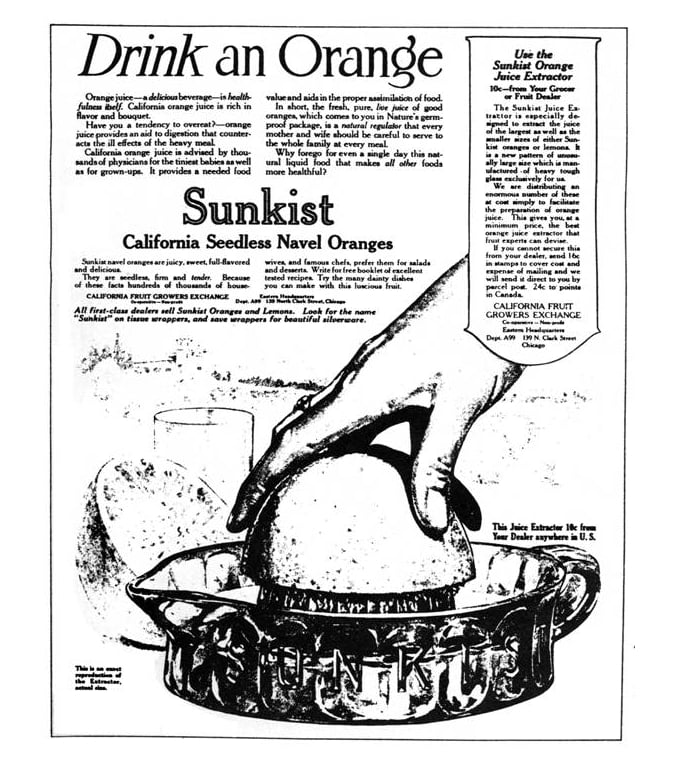
Believe it or not, there was a point in time when Sunkist was producing too many oranges, and they couldn’t sell them.
Unfortunately, they had to begin cutting down orange trees to reduce their production until a copywriter by the name of Albert Lasker saved the day.
He began working with Sunkist and came up with the idea of orange juice, which wasn’t a common drink back then.
The two produced and patented an orange juice extractor that was sold for ten cents each. It was advertised under the “Drink an Orange” campaign, and American’s went wild for this new beverage.
This campaign helped Sunkist sell more oranges and no longer have to scale back operations.
Mailstation2 postcard
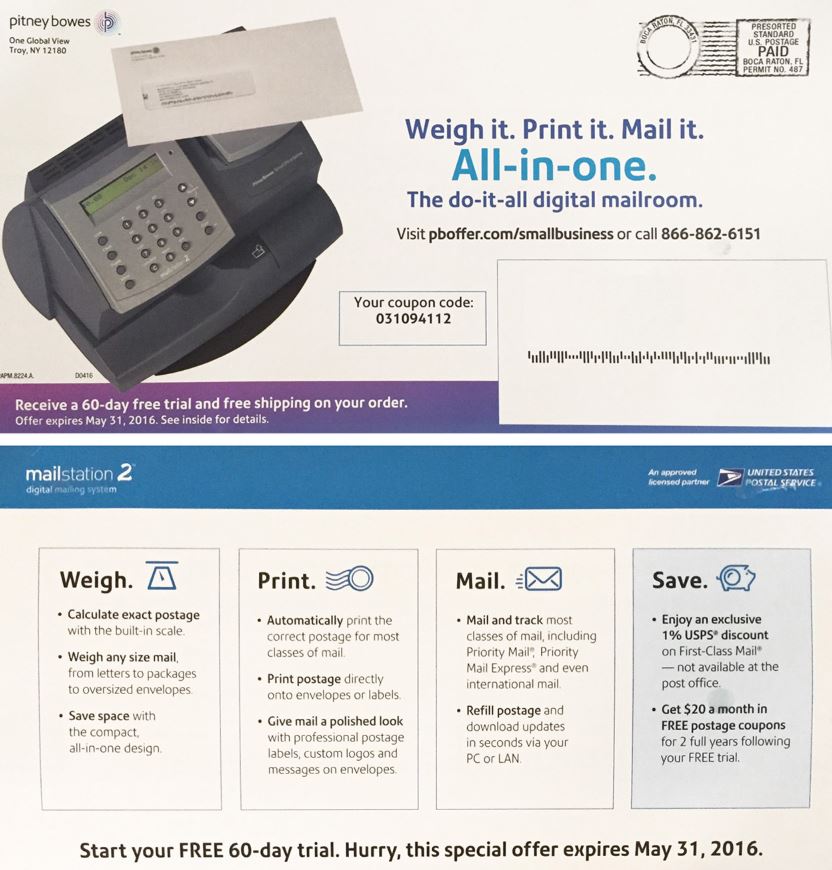
This was a postcard promoting Mailstation2, a machine that helps weigh, print, and send physical mail.
It begins with the headline “Weigh it. Print it. Mail it. All-in-one. The do-it-all digital mailroom.”
This does two things: states the main features and the value proposition of the machine being an all-in-one product.
The customer doesn’t need several tools to achieve the same thing when the Mailstation2 does it all.
A coupon code and a 60-day free trial with free shipping are provided to increase conversions.
Below the purple 60-day free trial banner, the offer “expires” to create urgency and is followed by a call to action.
It’s simple. The postcard uses all of the fundamental copywriting strategies that have worked for decades.
Learn more about these in my free and paid courses.
Final thoughts on what is copywriting
Copywriting is the art, science, and psychology of writing advertisements and business material that generates results.
Those results can be website traffic, sales, leads, or other metrics depending on the campaign.
Writing sales copy is not the same as writing website content, although there are many similarities in the skills and processes involved.
Despite this, they are two completely different crafts you will need to master individually.
A good copywriter is an incredible researcher, empathetic, and organized.
They produce content like sales letters, web pages, landing pages, and more.
Use the information you learned today to start your career as a copywriter or improve the hiring process if you run a business.
Furthermore, I recommend you check out my online training to level up your copywriting skills and income.
Here’s an infographic that sums up the main lessons:
